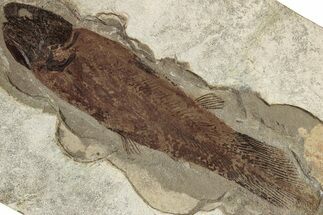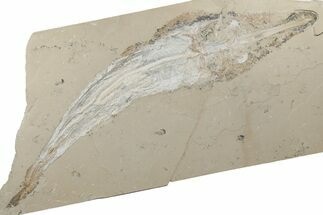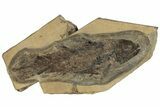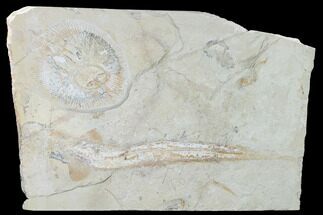This Specimen has been sold.
6.7" Rare, Undescribed Fossil Coelacanth - Kinney Quarry, New Mexico
This is an extremely rare and thus far undescribed fossil Coelacanth (Rhabdodermatidae) from the famous Kinney Quarry in New Mexico. There have only been a handful of Coelacanths found at this location and most were poorly preserved. This one is 6.7" long and in good condition. There are a few repaired cracks running through the rock and a small amount of gap fill restoration along the crack repairs.
An acrylic and metal display stand will accompany your purchase.
An acrylic and metal display stand will accompany your purchase.
The Kinney Lagerstätte is a world-famous Late Pennsylvanian fossil quarry located in the Manzanita Mountains of central New Mexico. The quarry is in the Tinajas Member of the Atrasado Formation and has been assigned a middle Missourian (Kasimovian) age of roughly305 million years. Since the first collections were made in the 1960s, the Kinney Quarry has been long appreciated by paleontologists for its exceptional preservation and diverse assemblage of fossil vertebrates, invertebrates, and plants. The New Mexico Museum of Natural History and Science, Smithsonian Institution, University of Kansas, Carnegie Museum of Natural History, Cleveland Museum of Natural History, and the Sam Noble Oklahoma Museum of Natural History have extensive collections of Kinney material. Due to the high scientific value of Kinney fossils and restricted quarry access, a very limited number of fossils from the site have ever become available for sale on the commercial market.
For more information:
Geology and paleontology of the Kinney Brick Quarry, Late Pennsylvanian, central New Mexico
AN UPDATE ON THE FLORA OF THE KINNEY QUARRY OF CENTRAL NEW MEXICO (UPPER PENNSYLVANIAN), ITS PRESERVATIONAL AND ENVIRONMENTAL SIGNIFICANCE
For more information:
SPECIES
Rhabdodermatidae sp.
LOCATION
Kinney Quarry, Bernalillo County, New Mexico
FORMATION
Atrasado Formation - Tinajas Member
SIZE
6.7" long
CATEGORY
ITEM
#206435
We guarantee the authenticity of all of our specimens.
 Reviews
Reviews















